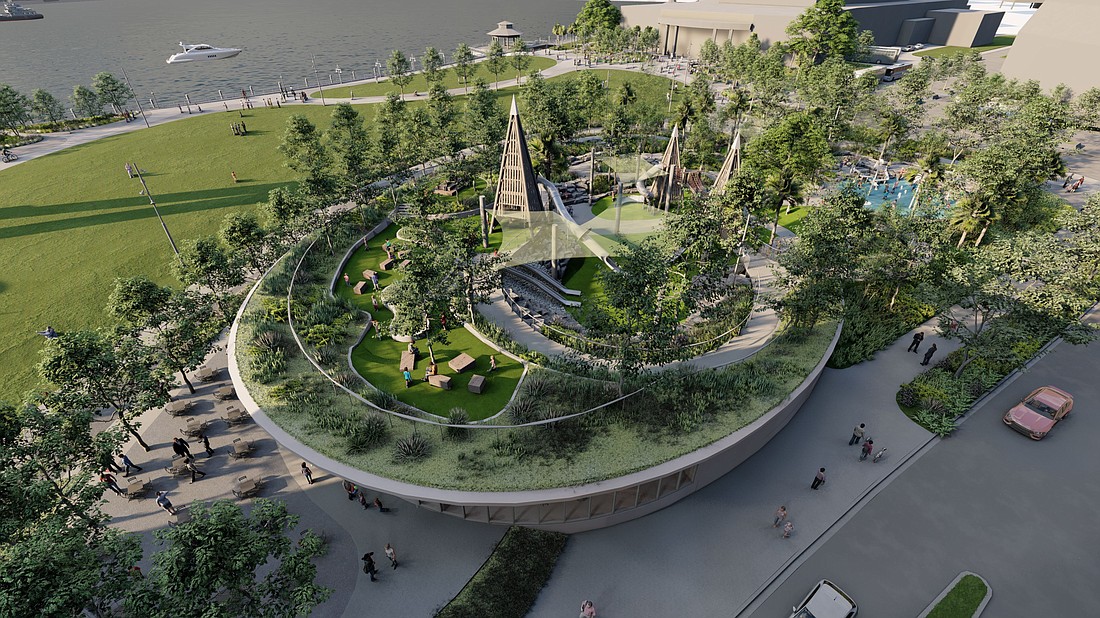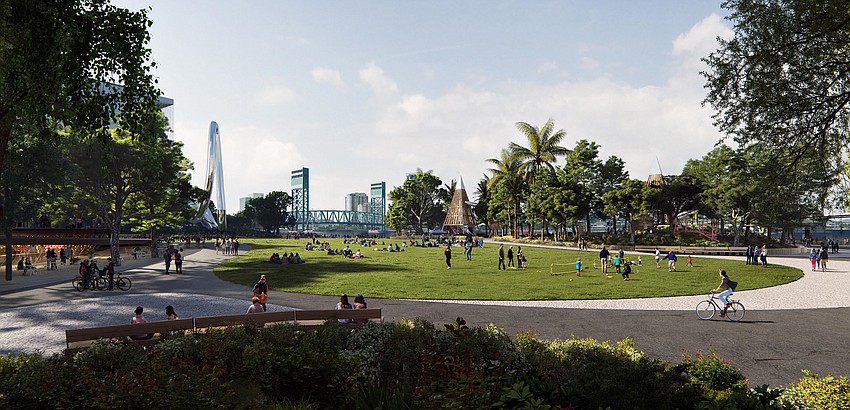
A City Council committee that raised concerns over the cost of three Downtown park projects voted Sept. 4 to reduce their price tag about 10%, with some committee members expressing frustration over what they described as being “handcuffed” to cost increases brought on by designs the Council did not approve.
The Finance Committee discussion on Riverfront Plaza, Shipyards West Park and Metropolitan Park ended with funding for the parks being cut by $20 million and with members calling for city administrators to keep the Council better informed about escalations in the costs of big-ticket projects.
Development of all three of the Northbank parks is part of the city’s community benefits agreement with the Jacksonville Jaguars, a companion to the $1.4 billion deal between the city and team to turn EverBank Stadium into the Jaguars’ “Stadium of the Future.” In June, the Council voted to provide $56 million in city funding to improve the parks as part of the community benefits agreement.
Some members of the Finance Committee said that when they approved the agreement, they believed the $56 million would cover the remainder of the city’s costs for building the three parks.
After discovering that total costs for the projects was $154 million as listed in Mayor Donna Deegan’s proposed Capital Improvement Plan for 2025-29, committee Chair Ron Salem froze $90 million in parks funding and called the Sept. 4 meeting for more information.
The five-year plan called for $68.2 million for Riverfront Plaza, $60 million for Shipyards West Park and $26 million for Metropolitan Park.

Committee member Raul Arias said the parks were too elaborate for the city to afford. He also questioned why there needed to be three high-priced parks on the Northbank, and why all of them were being developed simultaneously.
“We’re dreaming too far, too high and we’re not being realistic about what our current budget is,” he said.
Plans for Riverfront Plaza on the site of the demolished Jacksonville Landing include such features as a cafe and park office with a rooftop playground and a beer garden. Shipyards West, which neighbors the USS Orleck floating naval museum to the east, would include an event pavilion, sports courts, a kayaking area, boardwalk and more.
Metropolitan Park would be redesigned and upgraded.
Riverfront Plaza has been fully designed and work is underway on the first of two phases of construction. Shipyards West also has been designed, while Metropolitan Park has yet to undergo redesign.
Committee member Rory Diamond, who suggested capping the funding for the parks at the $56 million included in the community benefits agreement, said the projects were too much for the city to foot with other high-cost expenditures looming in coming years.

Those include funding for raises for police and firefighters, the stadium improvements, the community benefits agreement and eventually a new jail at a cost that has been estimated at $1 billion-plus.
“This means higher taxes,” he said, holding up meeting materials on the park costs. “There’s no way we can complete all this stuff without raising taxes.”
He and Arias both suggested stretching out the costs over a longer period of time and scaling down the parks to make them more affordable. Other ideas included selling naming rights to the parks and finding other revenue opportunities.

“If the Council has the stomach to demand we ratchet this back, I’m all there,” Diamond said.
Mike Weinstein, Mayor Donna Deegan’s lead negotiator in her administration’s negotiations with the Jaguars, warned the committee against “backpedaling” on its agreement with the team. He said the Jaguars entered the deal with the expectation that the parks would be completed by 2028 when the renovated stadium opens.
Salem questioned the city’s design and construction process, in which project budgets take shape as design work progresses and construction costs are estimated. He said it sounded as if city officials were simply letting designs drive up costs instead of setting a budget limit and sticking to it by altering designs.
“There’s no concept of, ‘Can we afford this?’” he said. “It seems like if you’ve got $60 million, the cost is $60 million and you’ve got to scale back.”
Nina Sickler, director of Public Works, said project costs have been escalating as much as 40% annually since the pandemic due to increases in construction costs.

Daryl Joseph, director of Parks, Recreation and Community Services, said that based on project reviews and conversations with committee members, staff determined that $10 million could be trimmed from each of the Shipyards West and Metropolitan parks without incurring extra costs for redesigns.
Weinstein said he’d spoken to Jaguars President Mark Lamping, who was comfortable with the $20 million reduction. The team, which has committed up to $150 million for its share of the community benefits agreement, will take the deal to the NFL owners during their meeting in October.
The City Council has yet to finalize the city’s contribution to the agreement, which in addition to the parks would provide for workforce development, homelessness services, affordable housing in the Eastside neighborhood north of the stadium and countywide. Deegan’s administration wants the city to commit $150 million.
The Finance Committee’s reductions for the parks funding are subject to a vote by the full Council.
The committee’s vote on removing the funding was 5-1, with Diamond opposed. Salem, Arias and members Nick Howland, Will Lahnen and Ju’Coby Pittman were in favor.
The meeting ended with Salem urging city officials to communicate more closely with Council members during the design and construction process.
“I thought we ended up in a good spot,” he said afterward. “We had a lot of good dialogue. I would have liked to see more come out than the $20 million, but I think there’s a commitment to take a look at everything and try to come up with some further cuts.”
Council member Jimmy Peluso, whose District 7 includes Downtown, said the parks would raise property values Downtown and boost city coffers, offsetting the need for a property tax increase.
Council member Matt Carlucci agreed, urging the committee “not to put the brakes” on development of the parks. In addition to a responsibility to be good stewards of tax dollars, he said, “We also have a visionary responsibility to our community to move the needle forward.”
“If we keep tiptoeing around this and don’t move ahead with resolve and with boldness, I think we’re really hurting the ability of what these parks can bring in a holistic manner of how we develop Downtown,” he said.
In community presentations, Downtown Investment Authority CEO Lori Boyer has described the parks as a key element in the Downtown revitalization strategy. The parks are designed to be destination attractions that draw local residents and visitors alike, creating more business for Downtown retail establishments and restaurants while also making Downtown a more inviting place to live.
In turn, having more full-time residents Downtown will add to the customer base for retail and restaurants, making it a more attractive place for businesses looking to start up, relocate or expand.